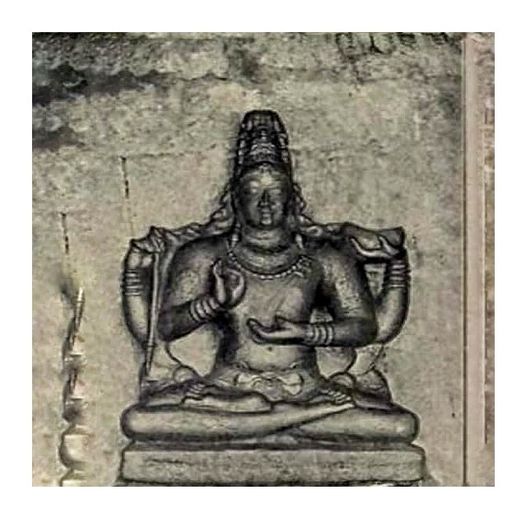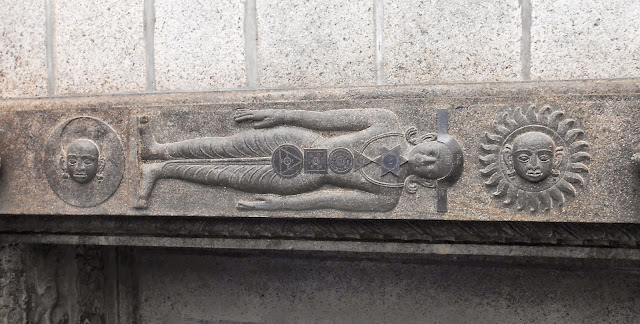This place, Thiruvalithayam, in the Thevara period, is now called Padi. This is the 21st Devara Paadal Petra Shiva Sthalam in Thondai Nadu. Since weapons for the war were stored in this temple premises, it is the so-called Padi. Sekkizhar mentioned the visit of
Thirugnanasambandar in his Periyapuranam.
திருவேற்காடு அமர்ந்த செழுஞ்சுடர் பொன்கோயில்சென்று அணைந்து பணிந்து திருப்பதிகம் பாடிவருவேற்று மனத்து அவுணர் புரங்கள் செற்றார்வலிதாயம் வந்து எய்தி வணங்கிப் போற்றிஉருஏற்றார் அமர்ந்துறையும் ஓதவேலைஒற்றியூர் கைதொழச் சென்று உற்றபோதுபெருவேட்கை தருவாழ்வும் பெற்ற தொண்டர்பெரும் பதியோர் எதிர்கொள்ளப் பேணி வந்தார்... பெரியபுராணம்Thirugnanasambandar has sung hymns in praise of
lord Shiva of this temple.
பத்தரோடுபல ரும்பொலியம்மலர் அங்கை புனல்தூவிஒத்த சொல்லி உல கத்தவர் தாம் தொழுது ஏத்த உயர் சென்னிமத்தம் வைத்தபெரு மான்பிரியாது உறை கின்றவலி
தாயம்சித்தம்வைத்தஅடி யார் அவர்மேல் அடை யாமற்று இடர்நோயே.
Moolavar :
Thiruvalleeswarar, Sri Valithaya Nathar.Consort : Sri
Jagathambigai
Some of the important features of this temple
are….The temple faces east and has a 3-tier
Rajagopuram. Balipeedam, Dwajasthambam, and Rishabam are after the Rajagopuram. In koshtam, Vinayagar, Dakshinamurthy, Vishnu
in place of Lingothbavar, Brahma, Durgai. Moolavar is a little big in size and
swayambhu on a square avudayar.
Ambal sannidhi faces south. Standing in one place near the rishabam, we
could have the darshan of Moolavar and Ambal.
In the inner praharam are Urchavars and Sannidhi for Somaskandar, Vinayagar (Vinayagar is with his two wives, Kamali & Valli). Subramaniyar, Meenakshi Sundareswarar, Nalvar, Hanuman worshiped lingam,
Suryan, Bharadwaja Lingam, Bhairavar, Arunagirinathar, Balamurugan and 63var
( Complete 63 vars are not there). In the outer prakaram Navagrahas and Guru
bhagavan.
Arunagirinathar visited this temple and worshiped Murugan. Also sang hymns in praise of
Murugan.
மருமல்லி யார்குழலின் மடமாதர் மருளுள்ளி நாயடிய னலையாமல் இருநல்ல வாகுமுன தடிபேண இனவல்ல மானமன தருளாயோ கருநெல்லி மேனியரி மருகோனே கனவள்ளி யார்கணவ முருகேசா திருவல்லிதாயமதி லுறைவோனே நிகழ்வல்ல மாதவர்கள் பெருமாளே ARCHITECTUREThe Temple consists of sanctum sanctorum, antarala, and ardha mandapam. A Two-tier brick Gajaprishta / Gajabrushta Vimana is over the sanctum Sanctorum. Stucco images of Shiva with Parvati, Dakshinamurthy, Maha Vishnu, and Brahma are on the Tala and Greeva kostams.
HISTORY AND
INSCRIPTIONSThe original brick temple existed between the 6th and 7th centuries. It was reconstructed during the Chozha period and extended during the Vijayanagara period. According to experts and Historians, the idols and sculptures belong to the 12th to 13th-century Chozha Period.
The Thevaram hymns mention this place as Thiruvalithayam, which was corrupted to Thiruvallithayam during the Chozha Period. According to the inscriptions, this place was under the Jayangoda Chozha mandala Pauzhal Kottattu, Kundrathur Nattu (?) Thiruvallithayam. Lord Shiva was called Thiruvalithayamudaiya Nayanar and Thiruvallithayamudaiyar, and Ambal was called Thiruveethi Nachiyar (AR 217 of 1910). The inscriptions mainly record the donations in terms of Kasu (money) and land donated to the temple for poojas, prayers, Naivedyam, and celebrations.
The inscription (214 of 1910), without the King's name
and period, records that Chitrambalamudaya Nayanar was installed from Thiruvenkadu,
for pooja Andhanars are also brought
from there and for their food a land was donated in This Thiruvalithayam which
came under Jayangonda Chozha Mandalathu Puliyur Kottam, Sangama Chozha Valanadu.
It also records that paddy is to be given to them, which should be measured in
Thirugnanasambandar Nazhi alias Marakkal.
Rajararaja-I’s 28th-year reign
inscription (216 of 1910) records the construction of the Kshetrapala
Pillaiyar temple, and Naivedyam land was also gifted to this temple.
During Rajaraja-I’s period, the inscriptions (218
& 219 of 1910) record that Naranan Yadhavarayan of Chalukya, two houses, and two Nandhavanam (flower garden) in Chinthamanipuram, a part of Padi, was
gifted to this temple. Also, Parameswaramangalathu Silambur Kottathu Silambanithan
Madhavarayan donated gold for the lighting of the perpetual lamp.
Parthivendravarman's 6th reign year inscription records the gift of 1350 Kuzhi Manchikkam land after sale to this Puliyur Kottathu Thudarmuni Nattu Thiruvalithayam temple by Puzhal Kottathu Ambathur NaEri Kizhl Nattu Kurattur alias Sri Parantaka Chaturvedi Mangalam sabha. As per the inscriptions, this place maintains the same name even after 1000 years, Korattur as Kurattur alias Sri Parantaka Chaturvedi Mangalam and Villivakkam as Villipakkam. The original inscription reads as...
ஸ்வஸ்திஸ்ரீ
கோப்பார்த்திவேந்திர பந்மந்தி
யாண்டு ஆறாவது
புழல் கோட்டத்து
அம்பத்தூரேரிக்
கீழ்நாட்டுக் குறட்டூராகி
ய ஸ்ரீபராந்தக
சதுர்வேதிமங்கலத்து
சபையோம் புலியூர்
கோட்டத்துத் துடர்
முணி நாட்டு
திருவலிதாயில் மகாதேவ
ர்க்கு யாங்கள்
எம்மூருடத் தெ ன்கழனி
சபை மஞ்சிக்கமான
நிலம் விற்பதற்குக்
கீழ்பால் அம்பத்தூரே
ரி நீர் கோற்றூருக்
குப் பாய்ந்த
காலின் மே ற்கு தெ ன்பால்..
அம்பத்தூரேரி
நீர் வில்லிப்பாத்துக்குங்......
Continued...
Vijayakanda Gopaladevar’s rule inscriptions (217 of 1910) record that Lady Dancers were brought from Kanchipuram and settled here. The inscription also records that jewelry and vessels were donated to Ambal, Thiruveethi Nachiyar.
Ref:1. Annual Report on South Indian Epigraphy, Year 1910.
LEGENDSThis is also one of the Guru parihara Shalam in
and around Chennai. The Guru, one of the Navagrahas, has incurred a curse out of
his lust and desire. To get rid of the Curse Maharishi Markandeya advised Guru
to worship Lord Shiva of this temple.
Bharadwaja, Ramar, Anjaneyar, Suryan, Chandran,
Indiran, and Valiyan (as birds) worshiped
Lord Shiva of this temple.
In another legend, Bharadwaja,
son of Guru Bhagawan, was born to Valiyan ( sparrow – கருங்குருவி ). Bharadwaja, depressed about his birth as Valiyan,
did penance on Lord Shiva of this temple. Pleased by the devotion, Lord Shiva
blessed him as a lord of birds. Hence, this place was called Thiru (Sri)
Valithayam, and Lord Shiva was also called Tiruvalleeswarar.
It was believed that this temple was used for
storing weapons during the war, hence, this place was called Padi. (To
support this, the temple authorities mention the Padavettamman, where soldiers
stayed and prayed before the war, and offerings after the war, which included Navakandam).
POOJAS AND CELEBRATIONS
TEMPLE TIMINGSThe temple will be kept
open between 06.30 hrs and 12.00 hrs and between 17.00 hrs and 20.30 hrs.
CONTACT DETAILS :The landline number is 044 2654 0706 and may be
contacted for further details.
HOW TO REACH : The temple is about 7.5 km from Koyambedu, 9.6 km from Chennai
Central, and 20 km from the Domestic Airport The nearest Railway Station is Anna Nagar Metro (4 km), and the nearest Junction is Chennai Central.
LOCATION OF THE TEMPLE: CLICK HERE
Consort : Sri
Jagathambigai
யாண்டு ஆறாவது புழல் கோட்டத்து
அம்பத்தூரேரிக் கீழ்நாட்டுக் குறட்டூராகி
ய ஸ்ரீபராந்தக சதுர்வேதிமங்கலத்து
சபையோம் புலியூர் கோட்டத்துத் துடர்
முணி நாட்டு திருவலிதாயில் மகாதேவ
ர்க்கு யாங்கள் எம்மூருடத் தெ ன்கழனி
சபை மஞ்சிக்கமான நிலம் விற்பதற்குக்
கீழ்பால் அம்பத்தூரே ரி நீர் கோற்றூருக்
குப் பாய்ந்த காலின் மே ற்கு தெ ன்பால்..
அம்பத்தூரேரி நீர் வில்லிப்பாத்துக்குங்......
POOJAS AND CELEBRATIONS
HOW TO REACH :
The temple is about 7.5 km from Koyambedu, 9.6 km from Chennai
Central, and 20 km from the Domestic Airport




































